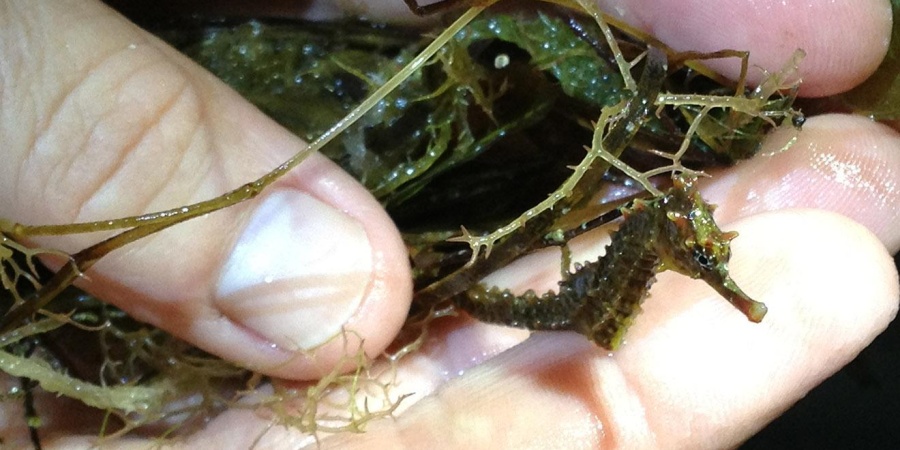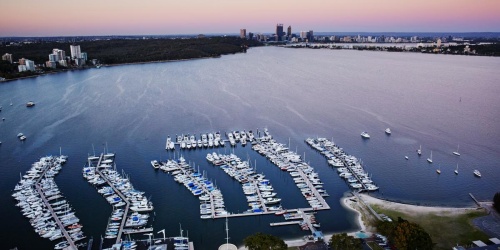
Seahorse in the Swan Canning Riverpark
The Swan Canning Riverpark and the rivers it surrounds are home to thriving ecosystems and a rich array of plants and animals.
The Swan River (Derbal Yerrigan) is 72km long. The Canning River (Djarlgarra or Dyarlgarro) is 110km. Together, these two rivers and their tributaries drain a catchment area of 2090km2 (209,000 hectares).
The Riverpark includes 7210 hectares of river reserve and adjoining public land.
Hydrodynamics of the rivers
The lower reaches of the Swan and Canning rivers form an estuary, where tidal forces and marine salinity can be detected. The estuary extends upstream to Walyunga National Park in the Swan River and the Kent Street Weir in the Canning River.
The Canning River forms a weir pool above Kent Street Weir that extends approximately 5km upstream. The pool has a relatively constant water level throughout the drier months and water is usually fresh.
Above Walyunga, the Swan is called the Avon River, although both waterways are actually the same river. The combined Swan-Avon River is 280km long and flows from near Wickepin. The Swan-Avon River drains a total catchment of approximately 126,000km2.
Swan and lower Canning rivers
The estuary in the lower reaches of the Swan and Canning rivers was created more than 10,000 years ago. The Swan River was mostly brackish before settlers removed the Fremantle bar in the late 1800s and dredged the large flood delta nearby. The Swan and Canning rivers are now a permanently open estuary that changes from fresh/brackish conditions in winter and spring, to salty conditions during summer and autumn.
A ‘wedge’ of saline water moves upstream from the ocean according to tidal and barometric forcing. This saline water is dense and tends to sit on the bottom of the river. When tides are strong and active, the wedge travels upstream along the bottom of the river, while less dense fresh water flows downstream over the top.
The hydrodynamics change with season and rainfall. In early spring, rainfall runoff and river flows decline. Sea water ingress is assisted by tides and moves progressively upstream during late spring and early summer. Through summer and into late autumn, the wedge often remains up to 55km upstream in the Swan and reaches the Kent Street Weir in the Canning. In very dry years, substantial salty water can remain up-river over the winter period.
In later autumn, freshwater runoff increases as rains arrive. Layering of freshwater over heavier, denser saltwater is common in the river. This restricts mixing of the bottom and surface waters, preventing oxygen replenishment from surface to bottom. Bottom waters can become hypoxic (low oxygen) and even anoxic (no oxygen) as decomposition of organic matter at depth depletes oxygen. Under anoxic conditions, the sediments may release nutrients which accumulate in the stagnant salty bottom water and contribute to algal blooms.
In late winter and early spring, the system is generally at its most fresh and the downstream extent of the saline wedge will depend on the amount of rainfall received.
Climate change is decreasing rainfall and increasing tidal heights and storm surges in the river system. This is impacting on the hydrodynamics of the river system.
Upper Canning River
The upper Canning River is separated from tidal flow and marine water by the Kent Street Weir. The weir has been in place for over 100 years and was originally constructed to prevent tidally driven saline water impacting agricultural land. The weir has changed the landscape – different flora and fauna exist above and below the weir that reflect the saltwater below and the freshwater environment above. During winter, the weir gates are adjusted to allow water to flow downstream and reduce the potential for flooding upstream. In summer, the gates are closed and the upper Canning River behaves like a freshwater pool. The weir is fitted with a fishway to allow fish passage when gates are closed.
Plants and Animals
The Swan and Canning rivers and their catchments support a diverse array of plant and animal life. Ecosystems range from freshwater pools in the upper reaches of the Canning River to wide estuarine expanses where salinity and tidal forces resemble a marine environment.
Aquatic animals
- more than 200 species of fish including bull sharks, cobbler, herring, mullet, black bream, whiting, flathead and blowfish
- four native freshwater fishes including freshwater cobbler, western minnow, western pygmy perch and nightfish
- Indo-Pacific bottlenose dolphins
- crustaceans including at least two species of prawns (king prawn and western school prawn), blue manna crabs and freshwater crayfish
- estuarine and freshwater mussels
- more than 80 species of waterbirds including the black swan, four species of cormorant, herons, darters, pelicans, ducks, ibises and egrets
- frog species including the motorbike frog, slender tree frog, moaning frog and squelching froglet
- long-necked turtle
- seahorses
- at least two species of jellyfish
Terrestrial animals
- forest and woodland birds including ospreys, parrots, hawks, kingfishers, honeyeaters, owls, magpies and cockatoos
- mammals including water-rats, quenda, brush-tail possums and bandicoots
- large reptiles including dugites, western tiger snakes, bob-tailed skinks and western bearded dragons as well many smaller lizards
- a fabulous array of spiders and insects
Plants
There are more than 1500 plant species associated with the Swan Coastal Plain. Plant communities associated with the river include:
- fringing forest communities with dominant overstorey species including saltwater sheoaks, swamp paperbarks, freshwater paperbarks and flooded gums
- saltmarsh communities
- sedge and rush communities
- veldt grass communities
Aquatic plants
- a wide array of aquatic macrophytes and macroalgae (seaweed)
- three species of seagrass species including Zostera meulleri, Ruppia megacarpa and Halophila ovalis, which is the most widespread.
- hundreds of species of microalgae (phytoplankton)
Invasive plants and animals
- weeds, mostly from nearby gardens, farmland, and market gardens
- invasive fish including pearl cichlids (Geophagus brasiliensis), goldfish (Carassius auratus), koi carp (Cyprinus carpio), mosquito fish (Gambusia holbrookii), silver perch (Bidyanus bidyanus), spangled perch (Leiopotherapon unicolour) and redfin perch (Perca fluviatilis)
- introduced invertebrates, including the Australian mud whelk (Batillaria australis), Asian paddle crab (Carybdis japonica), Asian bag mussel (Musculista senhousia) and the white sea squirt (Didemnum perlucidem)
